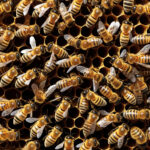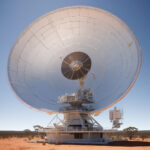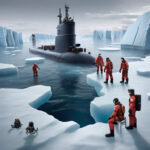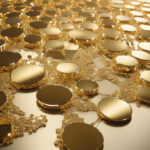This week, beauty’s biggest bust-up was all about semantics.
It started with a Vogue editorial showcasing former Miss Universe Olivia Culpo’s nuptials to San Francisco 49ers running back Christian McCaffrey. Once the online commentariat finished picking over her dress (Culpo said she ‘”didn’t want to exude sex in any way”), the discourse latched onto an otherwise throwaway comment about her beauty regime: Culpo said she wasn’t wearing mascara, lip liner or eyebrow makeup.
Eschewing quotidian cosmetics products on her wedding day, especially in the face of celebrity guests and when photographed for Vogue, seemed like a bold choice. Culpo told the magazine it stemmed from her desire for simplicity and elegance. What irked some readers was what went unsaid: Culpo may have skipped cosmetic products, but she appeared to still be relying on a bevy of semi-permanent beauty treatments.
“She has lip filler, Botox, lash lift and microbladed eyebrows so I can see why she doesn’t need makeup for that,” read a typical comment on one of many TikTok videos dissecting her suspected treatments.
Culpo denied getting lash extensions or brow lamination, but previously posted pre-wedding content that mentioned lash lifts, Botox and filler, as well as in-clinic facials.
Culpo has stepped into a fiery section of internet discourse. Wearing too much makeup can attract cries of fakery. But making a show of wearing no makeup at all can draw accusations of being a “pick me girl” (a woman who is deemed to be rejecting feminine traits to impress men) and allegations of being anti-feminist, or trying too hard to be relatable. There’s no winning.
“The whole ‘no makeup makeup’ thing is always a bit tongue in cheek,” said Lisa Payne, head of beauty at trends agency Stylus. “One could argue that if you’ve made any steps towards making yourself look better, even if you’ve put a moisturizer on, you’ve cosmetically altered yourself.” Still, plenty of commenters on Culpo’s wedding were positive, praising her for what they saw as a timeless look.
The conversation has only grown more complicated with the rise of treatments such as brow and lash tinting, lamination or microblading of the brows, spray tanning and even lip “blushing,” all of which have rapidly gone from the preserve of the ultra-wealthy to many women’s monthly beauty budgets.
Even before these treatments hit the mainstream, the no-makeup ideal elicited strong feelings. Alicia Keys was applauded by some when she “gave up” wearing makeup in 2016, but others pointed out that with her wealth and ready access to weekly facials, she could afford to skip foundation (In 2023, she decided to embrace wearing it again).
“If you’re not going to wear makeup, just shut up and don’t wear your makeup,” said Amber Leaux, one-half of the podcasting duo Style & City Diaries, adding that she found it equally odd when Kate Middleton, the Duchess of Cambridge, didn’t use a makeup artist for her wedding day. “It doesn’t make you one of us.”
Mirror, Mirror
The Italian expression for makeup is il trucco, which literally means “the trick.”
The main selling point of tweakments such as lash lifting and tinting, or brow lamination, is that they give the effect of having applied mascara or brow pencil, and last up to six weeks. It turns a daily ritual into a bi-monthly appointment.
Take eyebrows: in years gone by, you could have them shaped, perhaps dyed. If you had little to no hair left, tattooing was an extreme option.
Today, popular treatments include tinting, threading, lamination (a perm-style procedure that relaxes the hairs flat for a brushed-up look) or microblading, a permanent procedure that tattoos hair-thin strokes into the brow to reshape or densify them.
A quick scroll through social media – or the websites of Cosmopolitan and Allure – will give you an exhaustive guide to all the “high maintenance” things one can do to be “low maintenance.” Using a sunless tanner in the correct manner can take the place of foundation, bronzer and contour. A heatless curl wrap can fake a blowout overnight. Lash extensions, applied by a professional or at home, mean a lash curler and mascara is no longer needed. One slogan for DIY lash extension brand Lashify, which sells a $125 starter kit, is “mascara is dead.”
“If I have tweakments, of course I look good without wearing makeup,” said Leaux. “The reason I get my eyelashes done before I go on holiday is so I look peng when I wake up, so I don’t have to wear makeup.” [Peng is a British slang word meaning good or attractive].
Payne said that authenticity is such a prized quality for influencers and celebrities, when a mainstream face appears disingenuous, it angers viewers more than listing a series of expensive treatments might do. And the choice to detail the lack of makeup in proximity to Culpo’s other comments about wanting a pure, clean look was uncomfortable to some.
“There’s a certain sort of unwritten rule that [celebrities] are essentially a vehicle of inspiration for fashion and for beauty,” said Payne.
Though many celebrities, the most recent example being Sophia Richie Grainge, choose low-key beauty looks for their big day, by claiming not to wear makeup, Culpo didn’t let people play along. “[With Richie Grainge] viewers might not be able to afford all the products…but they could at least find dupes,” said Payne.
Culpo’s error then, was not choosing a simpler look, it was how she chose to present it. Saying you want to be a natural beauty doesn’t sit right with consumers when they know an extensive treatment plan has been undertaken ahead of the big day, said Payne. “It comes off more like ‘you can’t afford to look as beautiful as I do naturally on my wedding day’.”










